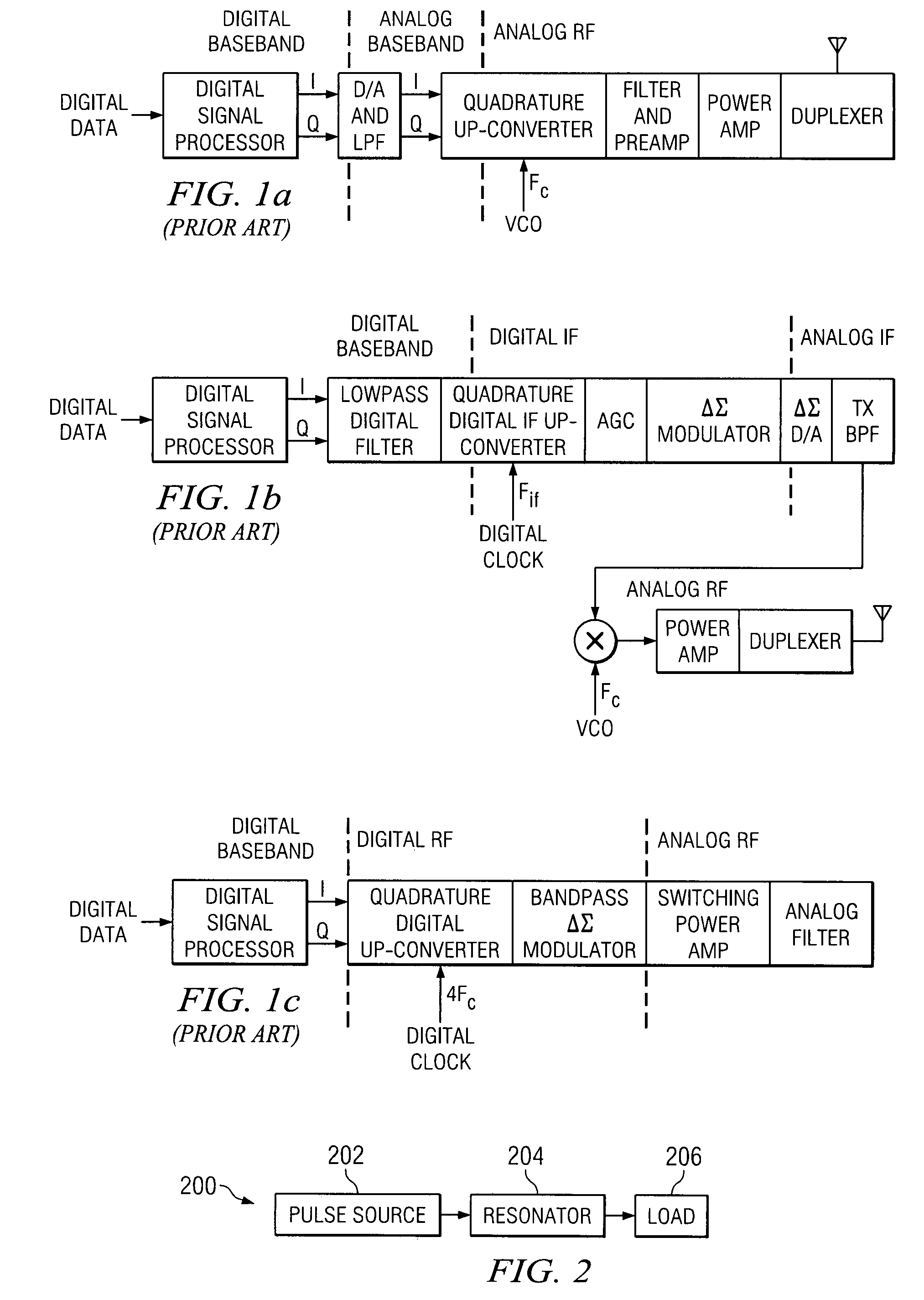Resonant power converter for radio frequency transmission and method
a technology of radio frequency transmission and power converter, which is applied in the field of radio frequency signals, can solve the problems of not providing any means for converting power to an rf carrier frequency, no means taught in the aforesaid disclosure, and the obvious less than optimal use of battery power, so as to improve the charging switch apparatus and reduce power consumption
- Summary
- Abstract
- Description
- Claims
- Application Information
AI Technical Summary
Benefits of technology
Problems solved by technology
Method used
Image
Examples
example 1
[0074]Referring back to the embodiment of FIG. 3, we choose L1=1 and L2=4. We also set the phase offset, θ=0, inside the cos( ) and sin( ) arguments driving the I- and Q-modulators. Data sample {ik} is the kth sample coming from the in-phase encoder 302a, and similarly, data sample {qk} is the kth sample coming from the quadrature encoder 302b. Using a clock at a rate 4Fc, which is four times higher than the carrier frequency Fc, samples from the encoders are effectively sampled and held by interpolators 318 four successive times before the next kth sample arrives. I- and Q-modulators 320 are effectively arithmetic multipliers. The multipliers each have two inputs and one output. I-modulator 320a receives the in-phase samples from interpolator 318a, and also receives a periodic sequence {1, 0, −1, 0}, which is the result of the trigonometric operation cos(2πn / 4), the in-phase version of the carrier frequency Fc having four samples per carrier cycle. Similarly, Q-modulator 320b recei...
example 2
[0075]As in the previous EXAMPLE 1, L1=1 and L2=4. This time, however, the phase offset, θ=π / 4, is set inside the cos( ) and sin( ) arguments driving the I- and Q-modulators. Note that setting the phase offset to π / 4 is important in some instances. In particular, the CDMA standards of IS-95, IS-95a, IS-98, and IS-2000 call for a π / 4 offset QPSK as a mode of modulation. It is well known to one of ordinary skill in the art of data modulation, that using π / 4 offset QPSK, as opposed to zero offset, has the benefit of reducing the peak-to-average, otherwise known as the crest factor. Going back to the prior description of operation, data sample {ik} is the kth sample coming from the in-phase encoder 302a, and similarly, data sample {qk} is the kth sample coming from the quadrature encoder 302b. Using a clock at a rate 4Fc, which is four times higher than the carrier frequency Fc, samples from the encoders are effectively sampled and held by interpolators 318 four successive times before ...
example 3
[0078]As in the previous EXAMPLE 2, L1=1, L2=4, and θ=π / 4. However, ternary quantization is used within the noise-shaping encoders 302. Therefore, there are nine possible data sequences every carrier cycle, and the constellation map would consist of a rectangular arrangement of nine symbol points at the following I-Q coordinates: (1,0), (1,1), (0,1), (−1,1), (−1,0), (−1, −1), (0,−1), (1,−1), and (0,0). The nine possible data sequences corresponding to these nine symbol points on the constellation map would therefore be: {1,−1,−1,1}, {2,0,−2,0}, {1,1,−1,−1}, {0,2,0,−2}, {−1,1,1,−1}, {−2,0,2,0 }, {−1,−1,1,1}, {0,−2,0,2}, {0,0,0,0}.
PUM
 Login to View More
Login to View More Abstract
Description
Claims
Application Information
 Login to View More
Login to View More - R&D
- Intellectual Property
- Life Sciences
- Materials
- Tech Scout
- Unparalleled Data Quality
- Higher Quality Content
- 60% Fewer Hallucinations
Browse by: Latest US Patents, China's latest patents, Technical Efficacy Thesaurus, Application Domain, Technology Topic, Popular Technical Reports.
© 2025 PatSnap. All rights reserved.Legal|Privacy policy|Modern Slavery Act Transparency Statement|Sitemap|About US| Contact US: help@patsnap.com



